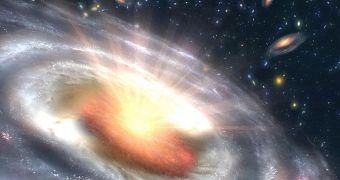In a new set of investigations, scientists discovered that quasars emitted massive blasts of radiation in the early Universe, essentially delaying the growth of dwarf galaxies by as much as 500 million years.
This period of accelerated universal warming took place an estimated 11 billion years ago, according to data collected via the refurbished Hubble Space Telescope.
Quasars are the highly luminous cores of active galaxies, and they can appear throughout the Universe. It would appear that they played a very important role in the early development of galaxies.
In a a paper to be published in the October 10 issue of the esteemed Astrophysical Journal, astronomers at the University of Colorado in Boulder (UCB) explain how they used Hubble to peer far back into the history of the Cosmos.
The era that was encompassed in the new research spans from 11.7 to 11.3 billion years ago, and it was analyzed via the Cosmic Origins Spectrograph (COS) instrument on Hubble.
The renowned space telescope was refurbished back in 2009, when space shuttle Atlantis astronauts changed its cameras, gyroscopes, and even its thermal shields, essentially extending its life.
Data from the COS device seem to indicate that the quasars' ultraviolet emissions were so strong, that they were able to strip electrons right off helium atoms. This process is called ionization.
Astrophysicists say that ionization is single-handedly responsible for heating up the Universe from 18,000 degrees Fahrenheit to more than 40,000°F.
One of the main consequences of such an event is that the gas in molecular clouds that would have otherwise collapsed to form new stars was prevented from doing so.
Stellar formation is the main factor contributing to galactic growth, right alongside mergers. Smaller galaxies were affected most by this temperature shift.
COS also allowed the investigators to take a closer look at the characteristics of intergalactic helium gas accumulations that existed in the early Universe. The previous Hubble Spectrograph was not sensitive enough to allow for this type of measurements.
“These COS results yield new insight into an important phase in the history of our Universe,” explains Eric Smith, who is a Hubble Program scientist at the NASA Headquarters, in Washington DC,
According to UCB expert Michael Shull, it took more than 2 billion years for the Universe to produce radiation sources that would reionize it, and allow for additional stellar formation to take place in dwarf galaxies.
“I imagine quite a few more dwarf galaxies may have formed if helium reionization had not taken place,” Shull argues.

 14 DAY TRIAL //
14 DAY TRIAL //